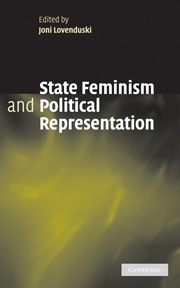Book contents
- Frontmatter
- Contents
- List of figures
- List of tables
- Notes on contributors
- Preface
- List of abbreviations
- 1 Introduction: state feminism and the political representation of women
- 2 Gendering political representation: debates and controversies in Austria
- 3 The Belgian paradox: inclusion and exclusion of gender issues
- 4 A politics for presence: state feminism, women's movements and political representation in Finland
- 5 Gendering the republican system: debates on women's political representation in France
- 6 WPAs and political representation in Germany
- 7 Gendering the debate on political representation in Italy: a difficult challenge
- 8 High tides in a low country: gendering political representation in the Netherlands
- 9 The women's movement, gender equality agencies and central-state debates on political representation in Spain
- 10 Party feminism, state feminism and women's representation in Sweden
- 11 Party government and women's representation debates: the UK
- 12 Women's policy agencies, the women's movement and representation in the USA
- 13 Conclusions: state feminism and political representation
- Appendix 1 Tables of women's representation in eleven countries
- Appendix 2 The RNGS model: summary of variable descriptors
- Index
Appendix 2 - The RNGS model: summary of variable descriptors
Published online by Cambridge University Press: 22 September 2009
- Frontmatter
- Contents
- List of figures
- List of tables
- Notes on contributors
- Preface
- List of abbreviations
- 1 Introduction: state feminism and the political representation of women
- 2 Gendering political representation: debates and controversies in Austria
- 3 The Belgian paradox: inclusion and exclusion of gender issues
- 4 A politics for presence: state feminism, women's movements and political representation in Finland
- 5 Gendering the republican system: debates on women's political representation in France
- 6 WPAs and political representation in Germany
- 7 Gendering the debate on political representation in Italy: a difficult challenge
- 8 High tides in a low country: gendering political representation in the Netherlands
- 9 The women's movement, gender equality agencies and central-state debates on political representation in Spain
- 10 Party feminism, state feminism and women's representation in Sweden
- 11 Party government and women's representation debates: the UK
- 12 Women's policy agencies, the women's movement and representation in the USA
- 13 Conclusions: state feminism and political representation
- Appendix 1 Tables of women's representation in eleven countries
- Appendix 2 The RNGS model: summary of variable descriptors
- Index
Summary
Cluster One: Characteristics of women's movement actors
Stage
Emerging/re-emerging: formation of new organisations; rehabilitation of older organisations toward new goals.
Growth: expansion in numbers of organisations, activities.
Consolidation: organisations have structure, endurance and regular support; institutionalised in community and government arenas.
Decline/abeyance: decrease in organisations, members and activities over the period; latent organisational activity primarily by individuals.
Closeness to left
Very close: groups formally ally with or work with political parties and/or trade unions of the left. Ideas from the movement are taken up by left-wing parties in party platforms. Activists have internal power positions in the left-wing parties.
Close: groups formally ally with or work with political parties and/or trade unions of the left. They do not have internal power positions in the parties or unions and if the left takes up the ideas of movements they do so without stating so and bring these ideas to fit the party line.
Not close: movement and the left are remote or hostile to each other.
Priority of issue
High: issue is one of the top priorities of the women's movement activists and serves to forge alliances among the various wings and tendencies.
Moderate: not a uniting issue, but is a priority for some activists and organisations.
Low: not a priority for any organisation, but mentioned by some. Not on the agenda. Not present at all on agendas of individuals and organisations in the movement.
Cohesion
Cohesive: movement organisations active on the issue agree on the frame and/or policy proposals.
Divided: movement organisations active on the issue disagree on the frame and/or policy proposals.
Information
- Type
- Chapter
- Information
- State Feminism and Political Representation , pp. 305 - 307Publisher: Cambridge University PressPrint publication year: 2005
